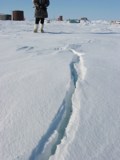|
|
Expedition
Expedition | People | More Pictures | Maps
|
April 13, 2005
by Andreas Muenchow
Previous | Next
Still Here |
When asked about the dangers of this expedition last week, I answered that "...The two most
dangerous aspects will be the wind and the wind..."

This proved very true today when four of our five tents were blown away in gale-force winds as
they were being set up off Greenland. There is very little that seven people subject to 70+ knot winds
(35 m/s) can do except to protect themselves from the elements. One tent is standing and that's
where everyone out in the field camp will be tonight. The last Helen and I heard in a phone call
about three hours ago was that everyone is safe and well and warm. Nevertheless, a Twin
Otter is on stand-by to help should an emergency occur. A
forecast for the area provided by Roger Samelson at Oregon State predicts that the winds are slowing down fast during the night. The picture below
shows a section of the wind speed with height above the surface to 2 km (~6000 feet) and ~100 km
(~60 miles) across from Ellesmere Island to Greenland. The contours are wind speed in m/s with a jet
centered both near the Greenland coast (60 km) and over Greenland (90 km) about 400 m above
sealevel.
About 400 miles to the south in Resolute Bay, there was very little wind, sunny and pretty warm at
about -10 F. Not knowing what was taking place off Greenland, Helen and I walked from the airport,
near where we are staying, to the town of Resolute. It was a brisk
2 hour walk along the road, across tundrea, over an ice-covered bay, into town. It is almost
impossible to notice the transition from snow-covered tundra to snow-covered sea ice were it not
for tiny cracks in the ice. Small tidal currents and sea level oscillations cause these cracks, it's
something I learnt only 2 days ago:

Arriving in town, we found a sign post telling us
direction and distances to locations such as the North Pole (1086 miles), and
Frederiction in southern Canada (1300 miles):
|
|
